Touch Objects at the Grey Art Gallery
Experience artworks In A New way!
NYU graduate students Auset Brown, Sauda Musharrat, and Rashi Chaudhary partnered with the Grey Art Gallery to create accessible representations of three artworks in Mostly New: Selections from the NYU Art Collection. These interventions explore how visitors can experience art in new ways beyond the visual through soundscapes and touch objects. Though designed to improve accessibility, they are for everyone to enjoy.
This project was created for the NYU graduate seminar “Access and Assistive Tech in Historical Sites and Museums,” taught by Anita Perr, Clinical Professor, Department of Occupational Therapy, Steinhardt and Amy Hurst, Associate Professor, Department of Occupational Therapy, Steinhardt; Department of Technology, Culture, and Society, Integrated Design and Media Program, Tandon School of Engineering.
Find these artworks:
Résonateur (Resonator) by Francis picabia
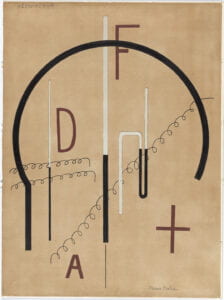
Since this artwork contains simple geometric shapes and symbols, it can be traced into a digital vector format and replicated using digital fabrication techniques. Our goal with the touch object is to maintain the accuracy and quality of the artwork and for visitors to be able to feel the exact brushstrokes, lines, and colors come alive beneath their hands. Each hue is represented through different textures, and overlapping lines are raised to signify different layers. We selected a size roughly equivalent to A4 (8.3 x 11.7 in) since it is the closest ratio to the board of the original artwork.
The base consists of the symbols and shapes that are red and white in the original artwork, as well as the spiral wires. Colors are distinguished through texture—raised for black, hollow for white, rough for red, and smooth for the tan background. Thin metal wires follow the spiral lines so that the viewer can experience this texture firsthand.
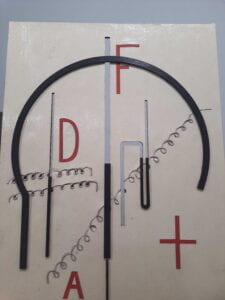
Rain by Jeanne Reynal
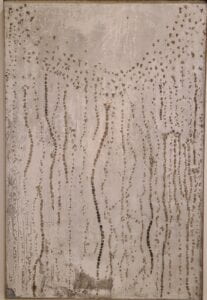
Jeanne Reynal
(White Plains, New York, 1903–New York, 1983)
Rain – Le Collier de Dieu, 1958
Smalti and dyed Japanese shell on pigmented cement
Grey Art Gallery, New York University Art Collection, Gift of the artist, 1962.41
Our goal is to represent this artwork with a soundscape that would invite the listener on a journey through the artist’s process, materials, and subject matter. At first glance, the viewer might see a large necklace with dangling stones that hints toward the title, Le Collier de Dieu, meaning God’s necklace. Some may see what can be interpreted as streaming droplets that allude to the beginning of the title, Rain. Thus in the soundscape we included the sound of rain storms with varying degrees of intensity and wind chimes to evoke jewelry and crystals clanging together.
We selected this work for the intricate, free-flowing forms that Reynal created by adding pieces of Japanese shell and opaque glass to the dyed cement in an energetic, spontaneous manner. The shapes created by the stream of shells and glass leave the viewer with many ways to understand the work
Soundscape duration: 2 minutes, 21 seconds
Portrait #9 by Philip Smith
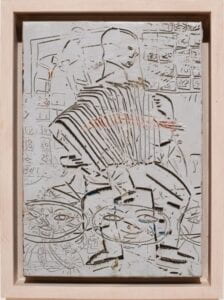
Philip Smith
(Born Miami, 1952; lives and works in Miami)
Portrait #9, 1992
Oil and wax on linen
Grey Art Gallery, New York University Art Collection, Gift of Cottrell-Lovett Collection, 2021.5.44
Philip Smith’s art is focused on exploring the mysterious nature of people and their day-to-day lives. At first glance, it is difficult to identify what is going on in the depicted scene. There is a dense cloud of imagery around a man playing an accordion. The artist includes many pictorial representations of emotions. Though this work is called a portrait, we are left without a clear identity for this musician, let alone a mood or narrative. The soundscape conveys this complexity.
This soundscape portrays the ambiguity of Smith’s painting by mixing music played on an accordion with noises from a busy street.
Soundscape duration- 1 min (on loop)
Map of where to find these artworks in the gallery:
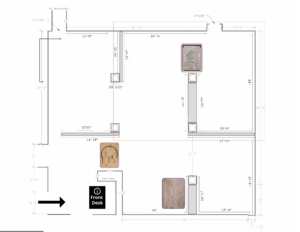
information for visitors:
- Bring headphones
- Collect leaflet at the front desk with the QR code for the soundscapes
- QR code also available next to the artwork
- Disposable gloves available for the touch object for Resonator
Please leave Feedback for Our Project
